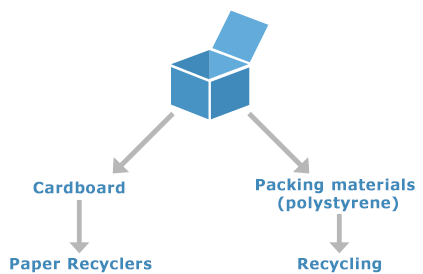Recycling Workflow
- Delivery


- Unpacking


- Disassembly by hand
Circuit boards


- Mines

-
Recycled into Precious Metals
Soldered points on ICs and condensers are melted and taken off circuit boards. Contact points are cut off and sorted using special equipment, and then pre-treated to improve the gold, palladium and platinum, etc., recovery rate when sent to a refining factory. The remaining parts of the circuit board are sent to a mine to recover precious metals and heavy metals in order to reduce the load on the environment.
Contact memory


- Refining Company

-
Recycled into Precious Metals
Soldered points on ICs and condensers are melted and taken off circuit boards. Contact points are cut off and sorted using special equipment, and then pre-treated to improve the gold, palladium and platinum, etc., recovery rate when sent to a refining factory. The remaining parts of the circuit board are sent to a mine to recover precious metals and heavy metals in order to reduce the load on the environment.
Plastics


- Specialized Factories

-
Recycled into Plastic
Plastics, which are widely used in body panels and parts, are procured as raw materials and, depending on the material, are pelletized and sent to factories where they are repurposed as raw materials or turned into oil. Plastics are also used as fuel by burning in a furnace, which is another way of recycling.
Iron/steel


- Steel Mills

-
Recycling into Ferrous Metals
Ferrous metals from body panels and parts are efficiently recovered on a dedicated rough disassembly line directly after the waste is brought in.
Nonferrous metals


- Non-ferrous Metal Manufacturers

-
Recycled into Copper and Aluminum
Copper is recovered from power supplies, CRTs and wires. Aluminum, nickel, stainless steel and other alloys are recovered from various parts. This work is carried out using specialized tools, and sorting is carried out repeatedly to recover all the different types of materials.
Glass


- Cullet Traders

-
Recycled into Glass
After going through a dedicated rough disassembly line, covers are sorted into plastics. CRTs go through another dedicated line for disassembly, nonferrous metals, such as copper and nickel, are recovered from the coil, electron gun and alloy parts, and glass parts are recycled by cullet traders.

